Korubo
- Self-denomination
- Where they are How many
- AM 127 (Funai, 2020)
- Linguistic family
- Pano
The Korubo, also known as the "clubber Indians" because of their war clubs, live in the region surrounding the confluence of the Ituí and Itaquaí rivers in the Javari valley. Most of the population (more than 200 people) still lives in isolation, moving between the Ituí, Coari and Branco rivers. In 1996, after various attempts, FUNAI contacted a small group of Korubo Indians. After the encounter with the attraction team, the Korubo began to visit the villages of the Matis Indians and the FUNAI encampments in the forest. Today the group is distributed in two communities on the lower Ituí.
This entry on the Korubu is largely based on data concerning the population contacted in the 1990s. When information on the isolated Korubo is included, this fact is mentioned in the text.
Names
The name used by the Korubo for themselves is unknown. Some researchers had previously identified the term dslala as their self-denomination. However recent work by the Javari Valley Ethno-Environmental Protection Front (FPEVJ) reveals that there is no single self-denomination used unanimously among the Korubo.
According to Pedro Coelho, the name Korubo was given by the Matis. The latter say that Korubo is a proper noun particular to Matis onomastics. One Matis man revealed the meaning of the word: “Koru means to be covered in sand, grey, dirtied by clay. The Korubo plaster clay on their skin to keep the mosquitos off, which is why they are dirty, covered in koru” (Arisi 2007: 108).
Philippe Erikson (1999: 74) ventures the hypothesis that Korubo is a generic designation for ‘enemy.’ Commenting on ethnonyms among the Northern Pano groups, the author emphasizes that the Kulina-Pano claimed to have exterminated a group that lived on the Esperança creek, an affluent of the Curuçá River, whose nickname was Korubo. However it is likely that these were not the Indians designated by the same name today.
Language
The Korubo language has yet to be classified, but probably forms part of the Pano linguistic family, fairly similar to the languages spoken by the Matis and the Matsés (Mayoruna), who live in territories adjacent to that of the Korubo. Because of this linguistic and geographic proximity, most of the group understands and speaks the languages of the neighbouring peoples, especially the Matis language.
It is known that the small Korubo group contacted in 1996 were able to comprehend Matis, an ethnic group with whom they have established good relations. However it is important to stress that the groups were mutual enemies prior to contact and hence have a shared history of rivalries and wars. Currently, because of this history marked by deaths, abductions and destruction of dwellings, the Matis remain somewhat fearful of the Korubo who continue to live in isolation.
The influence exerted today by the Matis on the Korubo is considerable and fairly explicit. One clear example is the fact that they use the Matis language to dialogue with the members of the Javari Valley Ethno-Environmental Protection Front (FPEVJ). The post-contact trajectory contributed to a better understanding of the Matis language, since the Contact Front and later the FPEVJ prioritized the Matis as interpreters and as mediators of the activities with the Korubo.
The Korubo also understand the Matsés (Mayoruna) language, but not as well as Matis.
Some people from the group who have had more frequent contacts with members of the Front understand and speak Portuguese reasonably well. They face pressure from the group to learn Portuguese in order to interact with non-indigenous Brazilians more fluently. The Korubo often hear remarks and accounts from the Matis concerning their visits to the city, which leaves them highly curious. However despite having a reasonable knowledge of Portuguese, the Korubo avoid talking in the language, preferring to use Matis (or the Matis themselves as interpreters) to communicate with members of the Front. It is also noticeable that they have appropriated some Matis words and incorporated them into their own vocabulary.
As well as the Matis influence on the Korubo language, it is also noticeable that the Matis are highly valued by the Korubo. They defend the Matis in innumerable situations – both verbally and physically – especially during conflicts with other ethnic groups and with the non-indigenous colonizers.
Localization
The Korubo inhabit the region surrounding the confluence of the Ituí and Itaquaí rivers, right shore affluents of the Javari, the river lending its name to the Indigenous Land in which they live. The Vale do Javari IL is located in the far west of Amazonas state and includes the border region between Brazil and Peru.
As well as the Korubo and other isolated groups, the Vale do Javari IL is also occupied by seven ethnic groups that have established various kinds of contact relations with the surrounding non-indigenous society: the Kanamari, Kulina Pano, Kulina Arawá, Marubo, Matis, Matsés (Mayoruna) and a small group called Tsohom Djapá. It is important to stress that the region formed by the IL and by the areas drained by the Manu and Purus rivers in Peru is the location with the highest number of isolated indigenous peoples in the world.
Population
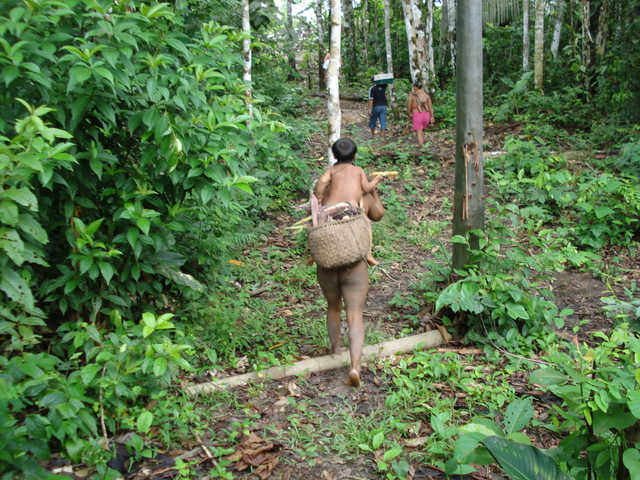
The census produced by the Javari Valley Ethno-Environmental Protection Front in 2007 counted 26 people. However at the end of the year a child with congenital problems had died, leaving a population of 25.
Over the last decade there has been a sizeable demographic increase. Based on the earlier censuses, since contact there has been a rise of around 50% in the group’s size. However the male population is predominant, which makes new marriages difficult: there are 14 males and 11 females (six of the latter are girls still and the rest are married). One of the adult men is unmarried and talks about looking for a companion among the Korubo who remain in isolation. Nonetheless it is very difficult to find a wife among the isolated groups since there is a risk of being killed.
Currently the Korubo are afflicted by a variety of diseases, such as malaria (at the start of 2008 all the members of the group were infected) and other illnesses resulting from contact. In May 2008 a taskforce from FUNASA (Brazil’s National Health Foundation) in cooperation with the Armed Forces and various institutions providing healthcare support visited the group with the aim of assessing the most common diseases among them and the providing care to the entire contacted population. The taskforce counted four cases of hepatitis C among the Korubo, along with two people who had been contaminated by the hepatitis B virus but had obtained natural immunization, while more than 50% had yet to be immunized by the antiviral vaccines.
The most likely source of the infection was the Matis given that the latter frequently visit the cities of Atalaia do Norte and Benjamin Constant, areas with a concentration of viral diseases such as hepatitis B (VHB) and C (VHC) and the HIV virus. This is compounded by the fact that hepatitis viruses A, B and C have increasingly affected the Matis leading to an exorbitant rise in the number of cases in the villages.
It has already been mentioned that the Matis in general are highly esteemed by the Korubo. Making use of this alliance, the Matis use the Korubo communities as a shelter and point of support during their trips to the closes cities. Consequently when they return they spend the night in the Korubo village, since these are located on the same river that leads to the Matis communities, but in an area closer to Atalaia do Norte and Benjamin Constant.
Contact History
The expansion fronts and contact experiences
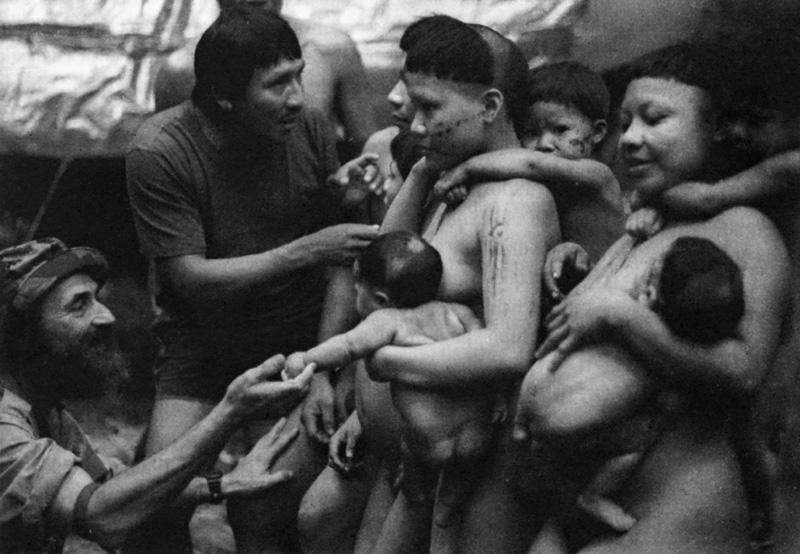
There are records of sporadic contacts with the group since the 1920s. According to a survey of the conflicts in the Javari Valley (1996) undertaken by the former Department of Isolated Indians, the oldest record of a massacre of Korubo Indians dates from 1928 when more than 40 of the population were killed by a Peruvian group accompanied by Ticuna Indians.
At the end of the nineteenth century and the start of the twentieth, the economic exploration of the interior of the Javari Valley began, catalysed by the global rubber boom. Many Indians were forced to work under slave-like conditions in exchange for a few manufactured goods and their own survival. They had two choices: either work for the so-called ‘patrons’ or be exterminated. During this period various indigenous groups became extinct and those that survived were heavily depopulated.
Some years after the start of rubber extraction in Amazonia there was a period of economic stagnation caused when rubber started being cultivated in Asia. The fall in the price of rubber led to companies becoming bankrupt and consequently a decline in the number of non-Indians occupying the Javari Valley region. This economic situation contributed to the restructuring of the surviving indigenous groups. However the pressure from colonial expansion in the region did not simply vanish. The peoples who lived in the terra firme areas of the Javari Valley, away from its floodplain, remained ‘isolated’ until the 1950s when logging activities increased and reached their territories.
This led to the first conflicts with the isolated Indians. The Army itself brutally suppressed the peoples of the region in favour of the Peruvian and Brazilian business leaders who felt threatened by the Indians and who were interested in their lands.
By the 1970s, a considerable area of the interior of the Javari Valley was already occupied by a non-indigenous riverside population who considered themselves the legitimate occupants of the region. They exploited the labour of the ‘tame’ Indians and exterminated those groups who showed any resistance, the so-called ‘wild’ Indians. The Korubo were – and remain – among the cohort of ‘wild Indians’ who populated the collective imagination of the region.
During the same decade the Brazilian state oil company Petrobrás also entered the area, beginning seismic research involving making clearings in the forest and carrying out test explosions. These environmentally damaging activities intensified the conflict between Indians and non-Indians in the region and contributed even further to the tension, forcing isolated groups, including the Korubo, to disperse.
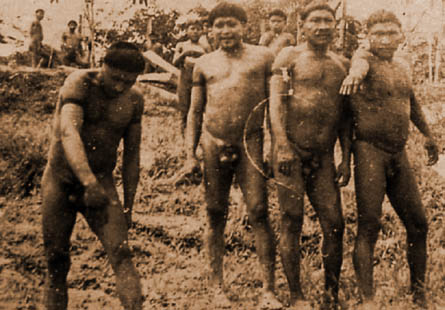
FUNAI began its work in the Javari Valley in 1971, providing support to the opening of the Perimetral Norte (Northern Perimeter) highway, which formed part of the National Integration Plan. To this end it set up the Solimões Frontier Advanced Base in the city of Atalaia do Norte, creating five Attraction Fronts for areas deep within the Javari Valley. Most of them ended up providing assistance to already contacted groups, later transforming into Indigenous Posts.
The Marubo Indigenous Attraction Post (IAP) was created in 1972, on the right shore of the Itaquaí River, a short distance upriver of the Marubo creek. A team led by Sebastião Amâncio da Costa had the objective of establishing peaceful contact with the isolated Indians known as ‘clubbers,’ the name given to the Korubo regionally. At the time FUNAI believed that this isolated population belonged to a Marubo group.
One year after the installation of the IAP, when some contacts with the isolated group had already been made, there was a Korubo attack on the Post, resulting in the death of the family of the FUNAI employee Moisés. In the same year, there was also another Korubo attack, which killed the employee Sebastião Bandeira and seriously injured another, Bernardo Muller.
After these incidents the Marubo IAP was transferred to the opposite shore, downriver of the confluence of the Itaquaí and Branco rivers, and was headed by the FUNAI field officer, or sertanista, Valmir Torres. According to the latter’s reports, the Indians always arrived armed and behaved in hostile fashion when visiting the camp. He believed that the group’s self-denomination was Kaniwa (today it is known that kaniwa means brother-in-law in various Pano languages).
In November 1974 the Post team entered into contact with a Korubo group. The next month various flights were made to locate the malocas on the left shore of the Ituí River. According to the Identification and Delimitation Report for the Vale do Javari Indigenous Land, in February 1975 “around 200 Korubo appeared on the shore opposite to the IAP.”
The same year the Korubo once again visited the post and asked for machetes, axes and other things. The day after the visit the team located a village with six malocas and around 200 Indians. However the IAP was attacked again by the Korubo, causing another death, that of FUNAI worker Jaime Sena Pimentel, in 1975. Due to this episode and the failures to approach and make peaceful contact, the post was deactivated.
At the start of 1982 the Itaquaí Attraction Post was created. Led by the specialist in indigenism, Pedro Coelho, and camped at the site known as Jó, a new attempt was made to approach the Korubo. In March, Coelho reports that the Indians had taken the presents left by the team at one of the attraction posts. A few days later, the team encountered a Korubo group on the shore of the Itaquaí River. Binan Matis, who worked as an interpreter at the IAP, understand some of the words spoken by the Indians. The next day the Indians appeared again, painted red with annatto and without any weapons.
The third contact occurred a month later. Just like the first time, the team remained in a boat. However the Korubo swam across and clambered on board to talk for five hours. Their behaviour oscillated between peaceful and aggressive. Binan Matis was again the interpreter during the conversation. On this occasion it was discovered that a Korubo youth was sick, possibly with malaria. The next day they came back in search of more presents, but there was no more items at the post to distribute.
The Korubo reappeared only in July, considerably weaker and thinner than usual. This time they stayed for four hours, communicating at a distance from the shore opposite to the post. The next day they reappeared at the same spot. Five of them swam to the boat and were treated with medications by the Post’s employees. The Korubo told Binan Matis that there were more sick people in their maloca.
However, after these friendly contacts a new attack was made by the Korubo, who killed the FUNAI employees Amélio Wandik Chapiwa and José Pacifico de Almeida. This attack was sufficient to deactivate the IAP. In fact the IAP became a Surveillance Post that also failed to have its intended effect, since it was unable to remove or even bar the entry of new invaders into the isolated Indians’ territories. Around this time a flight was also made over the region that located various malocas.
In 1983 Petrobrás began seismic surveys in an area close to the first Marubo IAP. A year after its activities began, two Petrobrás workers were killed by the Korubo.
All these killings by the Korubo were a response to the attacks perpetrated by the regional population against them. Since these attacks are unrecorded, it is difficult to calculate the number of Indians who died or were wounded.
After the death of the Petrobrás workers, for example, various burnt malocas were found along with one dead Korubo man. According to the survey of the conflicts undertaken by FUNAI’s Department of Isolated Indians, rubber tapper Indians, armed with guns and assisted by Flávio Azevedo, massacred an unknown number of Korubo Indians on the Itaquaí river in 1979. In another episode, in 1981, the same Flávio Azevedo, with the help of Manoel Vicente and João Bezerra, distributed poisoned flour to a Korubo group on the Itaquaí River. In 1985 a Kanamari man found the body of a Korubo Indian on the Itaquaí River. In 1986 three Indians were killed members of the non-indigenous regional population.
Despite the fact that these attacks on the Korubo are widely known, recounted by the regional non-indigenous population itself and contained in FUNAI’s records, only three have been officially registered. And even so, the culprits remain free and investigations have been shelved.
In the 1990s, two incidents, which resulted in the death of non-Indians from the region, led to FUNAI reinitiating the work of making contact with the Korubo. Due to the denunciations made by the Regional Administration of FUNAI in Atalaia do Norte on the organization of punitive expeditions and the constant incentive given to exterminating the Korubo by the mayor of Atalaia do Norte, along with local councillors and business leaders from Atalaia and Benjamin Constant, a small Korubo group was contacted by the Contact Front team, subordinated to FUNAI’s Department of Isolated Indians (today the General Coordination Office for Isolated Indians).
Official contact with FUNAI
The first real progress in making contact with the Korubo occurred in August 1996 when a village was located. The team, headed by the FUNAI field officer (sertanista) Sidney Possuelo, towed the Jacurapá, a boat used by the Surveillance Post, to the mouth of the Ituí River. Another boat, the Waiká, provided support to the incursions upriver, especially for visits to the tapiri shelter – a rough dwelling, covered with straw, made by the members of the Contact Front on the shore of the Ituí River, close to the path leading to the village. This was where the presents used in ‘attraction’ were left.
The following passage is from the report by sertanista Sidney Possuelo, referring to the location of the village and the path used by the contact team:
We entered the swidden about 50 or 60 meters from the village, separated by a strip of forest of approximately 30 meters. The Indians replied to our singing, speaking a lot, but did not appear in the open. We calculated that most of the Indians were hunting or trekking in another part of the region. We remained in the swidden no more than 45 minutes. After we left some presents, we returned to the boat, clearing a trail which we hoped they would use to visit us. We were circled by the Indians for two nights. They imitated various animals and beat their war clubs on the ground, throwing sticks into the encampment. Nothing more of note happened and we returned. We have now achieved a physical connection between us."
On August 29th 1996 the members of the Contact Front did not find the presents they had left at the tapiri shelter. In response they left more presents and a bunch of bananas in exchange for the flour that had been rejected by the Indians.
On October 15th 1996 the team established contact with the group. On this occasion the Korubo group was formed by 18 people, four women, six men, two girls and six boys. At the start of 1998 one man and two boys died after contracting malaria.
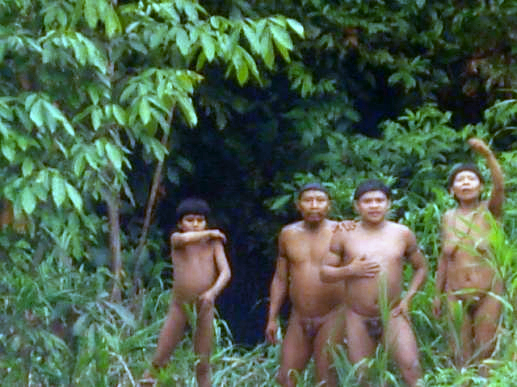
Ten months of work after contact, following more than 30 visits made by the Korubo to the Front’s base, members of the FUNAI team were attacked by the Indians with clubs, killing the worker Raimundo Batista Magalhães, nicknamed Sobral. Among the various interpretations of the episode, the most plausible indicates that the motive for the conflict was a tarpaulin taken by the Indians to build a tapiri shelter. Sobral went to reclaim possession of the tarpaulin and ended up destroying the tapiri as he pulled the canvas from the roof.
Sobral’s death was the result of a series of mistakes made by the Front, who failed to follow the guidelines passed in a memo to Sobral himself. Among the recommendations expressed in the document was the need to have a higher or equivalent number of Front members during any interaction with the Korubo, while another prohibited going across to the other shore of the river if the Indians appeared. Both guidelines were ignored.
Some days after this incident, the Korubo reappeared above the mouth of the Quebrado creek. According to the report written by the head of the Ituí IAP at the time, Korubo Indians were seen on the shores of the Ituí, who shouted and asked for food, among other things. The communication between the parties involved the mediation of the Matis. However at no moment did the team’s boat approach the river shore.
In November 1998, a group of five men, two women and two children appeared at the settlement called Ladário, close to the confluence of the Ituí and Itaquaí rivers, in search of flour and pans. There were no attacks but the community’s residents, fearful, asked for help from FUNAI and proposed the sale of their land to the entity’s administration in Atalaia do Norte.
The last attack undertaken by the Korubo was in 2001 when three loggers were killed on the Quixito River. The attack occurred during the period when the Ethno-Environmental Protection Front had cleared an area of forest to build the second Surveillance and Protection Post at a nearby location.
In 2000 the Korubo told Rieli Franciscato about the last massacred that they had suffered, which had probably occurred the year before contact. According to the report: “in July 1998, while we were treating the skin of a young Korubo man, as we were rubbing the cream on his body, we felt something that caught our attention and which was subsequently explained by the Matis interpreters: fragments of lead had penetrated various parts of his body. Other Indians then began to show us scars and gunshot wounds on various parts of their own bodies. Without much enthusiasm on their part and much insistence on ours, the Korubo told us about the events” (2000: 6).
The story can be summarizes as follows: six Indians went to a swidden belonging to the nawa (non-Indians) to take bananas and return to the village. On their return they stayed overnight at a place not far from the swidden. The next day they were ambushed by men who had been waiting for them on the path. The Indians were shot and two of them, a man and a woman, fell to the ground while the rest of the group fled and hid. After the assailants left, the Indians returned to the location where the two people had fallen and discovered the man dead. The woman still showed signs of life but failed to survive the trek back. As they were in severe pain from their injuries, they were unable to bury the bodies, yet alone carry them back.
According to the Korubo themselves, after running from the nawa, they hid at the location where they had been contacted in 1996. According to the description and information obtained from the Korubo, the authors of the attack were some residents from the riverside community Ladário, close to the confluence of the Ituí and Itacoaí rivers.
Currently the contact with non-Indians is restricted to the encounters with members of the Front, especially those from the Post team situated at the confluence of the Itaquaí and Ituí. Sometimes the Indians travel to the city in order to receive medical care.
Korubo Communities

The small Korubo group contacted in 1996 is today divided into two communities on the lower Ituí: one is situated very close to the Contact Front base while the other is located on the site of the former settlement of Mário Brasil. In principle the Korubo do not seem to name their communities. However some Indians have recently been calling the Mário Brasil community Tapalaya.
Each community is formed by a large maloca sheltering more than one family and by a number of smaller dwellings containing a smaller number of people. The maloca is similar to that of the Matis with a few differences: there are just one or two entrances without side doors. The newest maloca shares a number of similarities with the stilt houses typical to the region. It has a traditional outer form but inside it resembles the houses of the riverside populations with a suspended floor using paxiúba palm. There is also a house built in the same style as the latter. Some traditional houses possess holes in the ground to store war clubs, located next to the posts used to suspend the traditional hammocks, which were also given to the Front’s employees or the Matis as presents or in exchange for other items. It seems that each of the main posts in the maloca defines a family area and organizes the layout of the hammocks.
Close to the houses are the paths that lead to the sweet manioc, banana, peach-palm and maize swiddens.
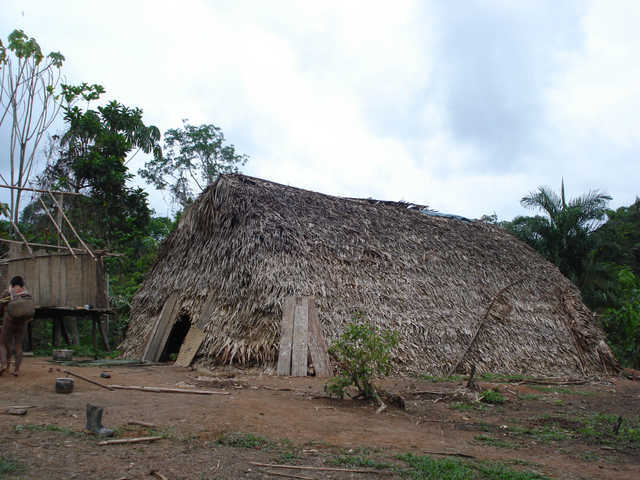
There is no FUNAI post in the communities but since 1996 the group has received assistance from the team of the Javari Valley Ethno-Environmental Protection Front, linked to the General Coordination Office for Isolated Indians (CGII-FUNAI). The team includes indigenous collaborators from the Matis, Marubo, Mayoruna and Kanamari, FUNAI staff and specialists in indigenism trained by the agreement between the Centre for Indigenist Work (CTI) and the CGII. There is also a health professional assigned by FUNASA.
The Surveillance and Protection Post located at the confluence of the Ituí and Itaquaí rivers, the Front’s base, controls and documents anyone passing up and down the river, including the indigenous inhabitants of the IL, to avoid the entry of anyone unauthorized by FUNAI and the potential contact with the isolated groups, as well as functioning as a barrier against invaders wishing to exploit the area’s natural resources. Travellers are always alerted to the presence of the isolated groups and the risks that contact may pose to these populations, especially in terms of disease transmission.
Cultural Aspects
Describing the rituals of the Korubo people is impossible since many practices fell into disuse after the split with the former isolated group. Today the group is basically formed by young people who did not have the chance to learn many aspects of their culture from the older generation. However they perform some dances and a type of wailing that is mixed with ritual singing.
In terms of material culture, the group uses almost exclusively the following hunting and warfare weapons: the blow gun, bows and arrows, war clubs and a type of spear. The blow gun dart is dipped in a poison made from extracts of two types of vine.
Pottery is still used in everyday life, though the vessels are now less frequently made due to their replacement by manufactured utensils given by FUNAI employees and the Matis.
Body decoration is less exuberant than the kinds found among other Pano groups. One traditional adornment is the tucum palm bracelet. Many of the items used today by the group have been appropriated from the traditional repertoire of the Matis, such as bracelets and ear perforations. The women use a strip of tucum palm fibre as a sling to carry their small children.
Another traditional feature of Korubo culture is the half-bowl (or half-moon) haircut: only the hair from the centre of the head to the forehead is kept with the rest shaved off with blades of a grass typical to the region. There is also another traditional cut involving shaving almost all the hair, leaving only a band from one ear to the other shaped like a tiara.
Korubo men drink a brew made from a vine called tati to give them strength and skill in hunting.
Sources of information
- AMORIM, Fabrício. Povos Indígenas Isolados da Terra Indígena Vale do Javari. CGII-FUNAI, 2008.
- ARISI, Bárbara Maisonnave. Matis e Korubo: Contato e índios isolados - Relações entre povos no Vale do Javari, Amazônia. Florianópolis. UFSC, 2007.
- CAVUCENS, Sílvio & NEVES, Lino João de Oliveira. Povos Indígenas do Vale do Javari. Campanha Javari. Manaus: CIMI, OPAN, 1986.
- MELATTI, Júlio Cezar. Povos Indígenas no Brasil. vol. 5. Javari. São Paulo: CEDI, 1981.
- CEDI. Aconteceu: Povos Indígenas no Brasil/1982. São Paulo: CEDI, 1983.
- CEDI. Aconteceu: Povos Indígenas no Brasil/1983. São Paulo: CEDI, 1984.
- CEDI. Aconteceu: Povos Indígenas no Brasil/1984. São Paulo: CEDI, 1985.
- COUTINHO, Walter. “Relatório de identificação e delimitação da Terra Indígena Vale do Javari.” Memo nº168/DEID/DAF/FUNAI, 158 p. Maio, 1998.
- ERIKSON, Philippe. 1999. El Sello de los Antepasados. Quito, Ecuador: Abya Yala/IFEA.
- _____. Los Mayoruna. In SANTOS-GRANERO, Fernando & BARCLAY, Frederica (ed.). Guía Etnográfica de la Alta Amazonía. Quito, Ecuador: FLACSO – Sede Ecuador/IFEA, 1994.
- FRANCISCATO, Rieli. Relatório sobre o Massacre de índios Korubo, ocorrido em 1995. DEII/FPEVJ- FUNAI, 2000.
- SÖDERSTRÖM, Erling. The Hidden Tribes of The Amazon. França: Striana-France Films, DVD (55 min.), 2002.